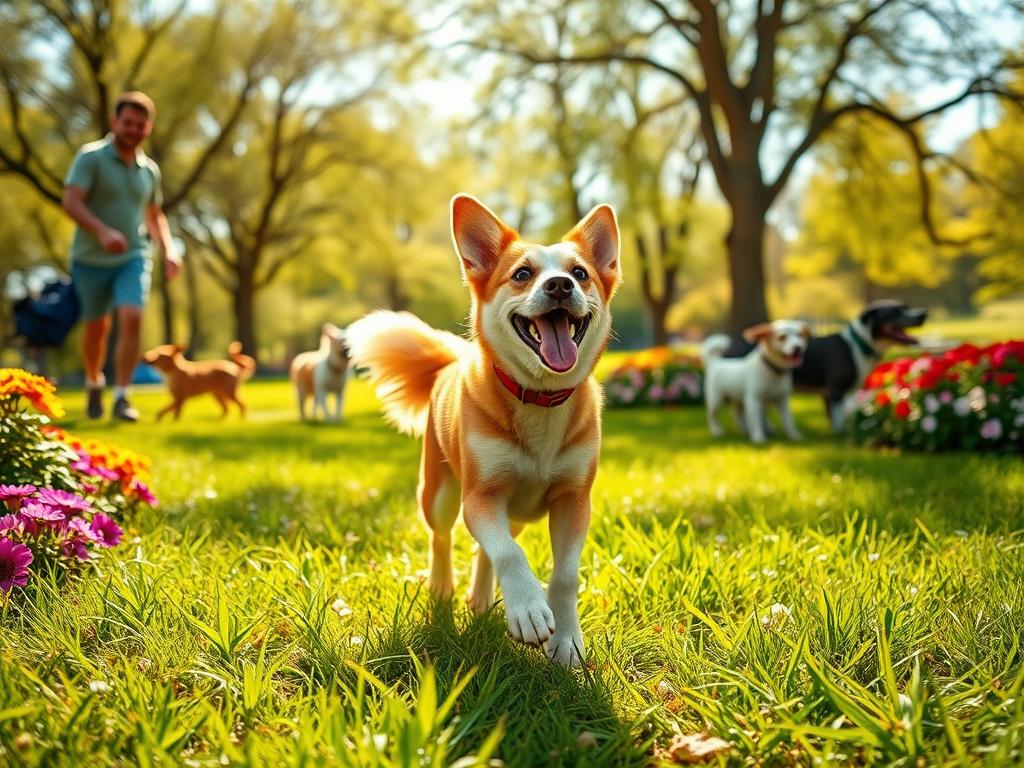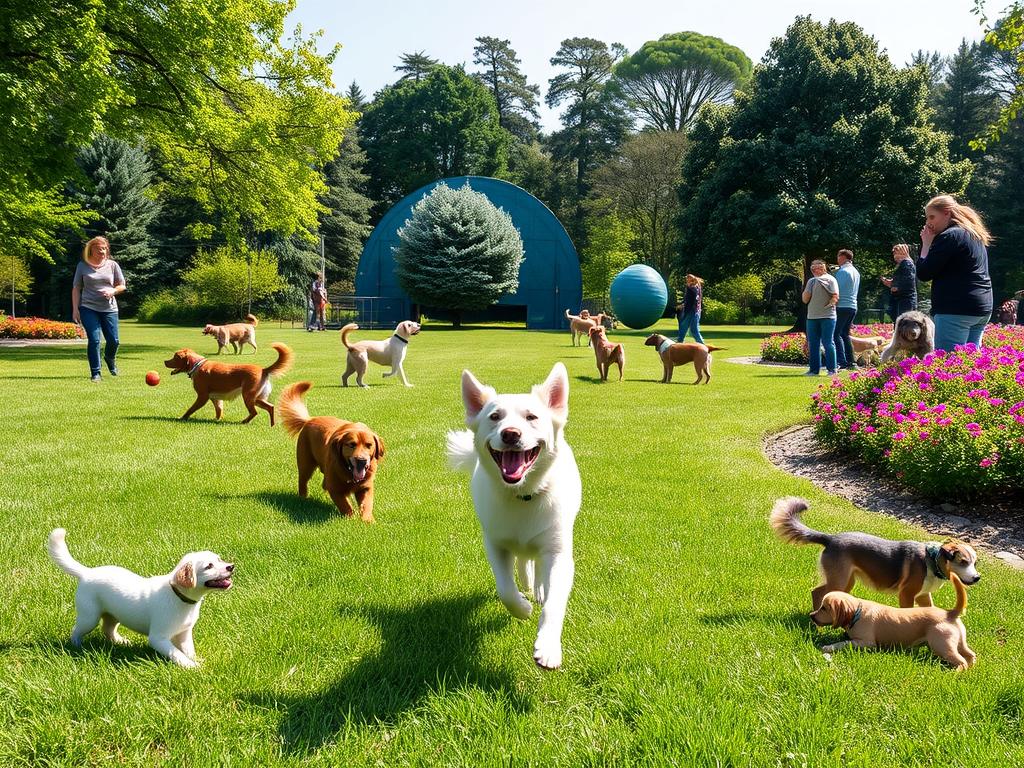Ever thought a simple walk could change your dog’s life? The role of regular exercise in your dog’s health is immense. Just as humans, dogs need physical activity for their well-being. Exercise keeps them at a healthy weight, improves their life quality, and can even extend their lifespan.
It’s easy to overlook the daily activities that impact our pets, leading to a sedentary lifestyle. This can lead to various health issues. In this article, we delve into the benefits of exercise for dogs. We explore how movement affects their lives, highlighting the importance of physical activity for their happiness and health.

Understanding the Role of Exercise in a Dog’s Life
Exercise is crucial for a dog’s health and happiness. It serves as a natural way to release pent-up energy, reducing boredom and anxiety behaviors. A dog that gets enough exercise is generally calmer and easier to manage at home.
Exercise also has significant psychological benefits. It strengthens the bond between dogs and their owners through play and walks. This interaction fosters companionship and positive interactions. Dogs benefit greatly from socialization, and exercise provides the perfect setting for this.
Furthermore, exercise meets dogs’ instinctual needs for activity and exploration. It boosts their mood and contributes to their overall happiness and stability. Ensuring dogs get enough exercise promotes a healthier lifestyle for them.

| Benefits of Exercise in Dogs | Physical Health | Mental Health |
|---|---|---|
| Weight Management | Maintains a healthy weight | Reduces anxiety and stress |
| Muscle Strength | Builds and strengthens muscles | Enhances confidence and happiness |
| Joint Health | Improves flexibility and mobility | Encourages playful behavior |
| Socialization | Fosters positive interactions with other dogs | Enhances social skills |
Health Risks of a Sedentary Lifestyle for Dogs
A sedentary lifestyle poses severe health risks for dogs. Obesity is a major concern, caused by a lack of exercise. This condition not only alters a dog’s appearance but also leads to diabetes and heart disease. Overweight dogs often suffer from joint problems, causing chronic pain and mobility issues.
Certain breeds, like Bulldogs and Dachshunds, are more prone to obesity. This makes them more susceptible to the health risks associated with a sedentary lifestyle. Veterinary studies show that inactive dogs experience a decline in quality of life and may have a shorter lifespan.
Behavioral issues often accompany physical health problems. Dogs may exhibit frustration through excessive barking or destructive chewing due to lack of physical outlets. Recognizing these risks highlights the need for a regular exercise routine for dogs.

| Health Issue | Description | Implications |
|---|---|---|
| Obesity | Excess body weight due to inadequate exercise. | Increases risk of diabetes and heart disease. |
| Joint Problems | Strain on joints from excess weight and inactivity. | Can lead to chronic pain and decreased mobility. |
| Diabetes | Insulin resistance caused by excess weight. | Requires ongoing management and can decrease life quality. |
| Behavioral Issues | Frustration from lack of physical and mental stimulation. | Can result in excessive barking or destructive behaviors. |
Dog Exercise Benefits
Regular exercise is key to a better life for dogs. It offers many advantages for their physical and emotional health. Dogs that exercise regularly see their physical health improve, reducing obesity and chronic disease risks. This leads to stronger bones and muscles, making them more active and living longer. Exercise also boosts their emotional well-being, bringing stability and happiness.
Improved Physical Health
Exercise is a major benefit for a dog’s physical health. It helps keep them at a healthy weight, preventing obesity. It also lowers the risk of chronic diseases like diabetes and heart disease. Moreover, it strengthens bones and muscles, keeping dogs agile and energetic as they age. This shows that active dogs often live longer, healthier lives.
Mental Stimulation and Emotional Well-being
Exercise is crucial for a dog’s mental stimulation and emotional well-being. Without it, boredom and anxiety can cause behavioral problems. Dogs that exercise regularly are happier and more stable in their behavior. Studies confirm a strong link between exercise and emotional health in dogs, highlighting the need for regular physical activity.
Choosing the Right Type of Physical Activity for Dogs
It’s vital to understand the specific physical activity needs of dogs for their overall well-being. Different breeds have unique exercise requirements. Active breeds, like Border Collies and Labrador Retrievers, need rigorous workouts. On the other hand, less active breeds, such as Bulldogs or Shih Tzus, prefer shorter walks or simple playtimes. Tailoring the right exercise ensures your dog stays healthy, happy, and engaged.
Active Breeds vs. Less Active Breeds
Active breeds require more physical exertion. They need intense exercise sessions daily, including running, agility training, and interactive dog games. These activities challenge their physical and mental capacities. In contrast, less active breeds are content with shorter walks or simple playtimes.
| Breed Type | Exercise Duration | Activity Suggestions |
|---|---|---|
| Active Breeds | 1-2 hours daily | Running, agility courses, interactive dog games |
| Less Active Breeds | 30-60 minutes daily | Walking, short play sessions, light fetching |
Interactive Games and Their Benefits
Interactive dog games are crucial for meeting dogs’ physical activity needs. These games provide exercise and enhance cognitive skills. They also strengthen the bond between dog and owner. Activities like fetch, tug-of-war, and puzzle toys stimulate both mind and body. They are ideal for dogs of all energy levels.
Creating a Canine Fitness Routine
Creating a successful canine fitness routine involves careful consideration of several factors. It’s essential to tailor the program to meet the dog’s needs, enhancing the experience for the owner. Understanding each dog’s unique requirements ensures they receive a balanced exercise regimen. This approach promotes their health and happiness.
Factors to Consider When Formulating a Routine
When crafting a canine fitness routine, consider these key elements:
- Age: Puppies and senior dogs have different exercise needs.
- Breed: Active breeds need more exercise than less active ones.
- Current Fitness Level: Evaluate your dog’s condition to avoid overexertion.
- Health Issues: Consult a vet if your dog has medical concerns.
Incorporating Playtime into Daily Activities
Daily playtime is crucial for any effective fitness routine. Engage in activities like fetch, tug-of-war, or obstacle courses. These make exercise fun and stimulating. By mixing play with walks and training, you create a positive atmosphere.
This not only boosts your dog’s fitness but also strengthens your bond. It makes the experience enjoyable for both you and your pet.
The Importance of Daily Walks for Dogs
Daily dog walks are crucial for your dog’s health and happiness. They provide physical exercise and mental stimulation. Dogs also get to explore their surroundings, fulfilling their instincts and keeping their minds sharp.
Pet owners should commit to at least 30 minutes to an hour of walking each day. Tailoring the intensity and duration to your dog’s needs ensures mutual benefits. Properly managed, these walks boost physical health, strengthening muscles and improving heart health.
Adding variety to your walks by incorporating different scents and sights can greatly enhance your dog’s mood and behavior. Social interactions with other dogs and people during walks also promote good social skills. These skills are essential for a well-rounded canine personality.
| Benefits of Daily Dog Walks | Description |
|---|---|
| Physical Exercise | Helps maintain a healthy weight and promotes cardiovascular fitness. |
| Mental Stimulation | Engages the dog’s mind through exploration and scent recognition. |
| Socialization Opportunities | Encourages interaction with other dogs and people, fostering good behavior. |
| Bonding Time | Strengthens the bond between owner and dog through shared experiences. |
Including daily dog walks in your routine significantly improves your dog’s well-being. It’s a key part of responsible pet ownership.
Maintaining Health in Dogs Through Regular Exercise
Regular exercise is vital for dogs’ health, aiding in weight management. A consistent routine helps dogs stay at a healthy weight, preventing obesity-related health issues. It’s crucial to mix up activities to keep dogs excited about exercising.
Promoting Healthy Weight Management
Exercise is key for healthy weight management in dogs. Dogs that stay active burn more calories, lowering obesity risks. This is critical, as obesity is a common health problem in pets. By focusing on exercise, you can extend your dog’s life and improve their health.
Strengthening Muscles and Joints
Exercise also boosts muscle and joint strength, crucial for mobility and flexibility. It’s especially beneficial for older dogs, improving joint health and mobility. Stronger muscles reduce injury and joint problems, enhancing your dog’s quality of life.
Benefits of Consistent Exercise for Pets
Regular exercise is key for pets, boosting positive behavior and social skills. It supports physical health and enhances socialization for dogs. Well-exercised dogs interact better with others, creating a more harmonious environment at home and in public.
Enhancing Socialization Skills
Socialization for dogs improves with consistent exercise. Dogs that exercise regularly become comfortable in various settings and with other animals. This familiarity reduces anxiety and fear, preventing aggressive behaviors.
Preventing Behavioral Issues
Exercise prevents behavioral problems caused by boredom or lack of activity. Pets without enough exercise may bark excessively or chew destructively. Exercise provides an outlet for energy, promoting calmness and reducing misbehavior. Regular play and exercise strengthen the bond between dog and owner.
Best Practices for Exercising Your Dog
Every dog owner strives to provide the best for their pet. Following the best practices for dog exercise ensures a fun and safe experience for both you and your pet. It’s crucial to understand your dog’s exercise limits to avoid injury and keep them motivated for outdoor activities. Also, incorporating essential safety tips for walking dogs can further enhance this experience.
Understanding Exercise Limits
Knowing your dog’s physical capabilities is key to their exercise routine. Different breeds have varying energy levels and exercise needs. For instance, high-energy breeds need vigorous activities, while less active breeds benefit from shorter, gentler walks. Watch your dog’s behavior during exercise. If they show signs of fatigue, such as excessive panting or reluctance to continue, it’s time to stop and let them rest.
Safety Tips While Exercising Outdoors
When exercising outdoors, safety is paramount. Always check the weather, as extreme temperatures can be harmful. On hot days, schedule outings during the cooler hours of the morning or evening to prevent overheating. Make sure your dog wears properly fitting gear, such as harnesses, for control and comfort. Hydration is crucial, so always carry water for your dog, especially during longer walks or hikes.
Setting a routine that aligns with your dog’s peak energy levels can optimize exercise outcomes while minimizing risks. The following table offers a glimpse into the proper setup:
| Time of Day | Activity Type | Recommended Duration |
|---|---|---|
| Morning | Brisk Walk | 30 minutes |
| Midday | Fetch or Tug-of-War | 15 minutes |
| Evening | Relaxed Walk | 20 minutes |
By following these best practices for dog exercise and implementing effective safety tips for walking dogs, pet owners can ensure enjoyable experiences. These experiences cater to their dog’s physical and emotional well-being.
Dog Health and Exercise: A Balanced Approach
A balanced approach to dog health involves both exercise and rest. Dogs need activity to thrive but also require time to recover. Just as humans need rest after intense workouts, dogs do too. This ensures their bodies can heal and stay healthy.
Creating a routine with different types of exercise is key to enhancing dog wellness. It’s vital to watch the intensity and length of activities to prevent overdoing it. Regular vet visits are crucial for adjusting exercise plans based on the dog’s health. A proper diet is also essential, supporting their activity levels and overall health.
By focusing on a balanced approach to dog health, including exercise, rest, and nutrition, owners can greatly improve their pets’ lives. This holistic approach not only improves physical health but also boosts emotional stability and mental well-being.
Promoting Well-Being in Dogs Through Activity
Creating a nourishing atmosphere for exercise is crucial for a dog’s well-being. Dogs are more eager to engage in physical activities when they feel comfortable. Several key components contribute to a comfortable exercise environment, enhancing the overall experience for your dog.
Creating a Comfortable Environment for Exercise
A few factors can significantly influence the quality of your dog’s exercise routine. These contribute to not only a productive workout but also a joyful atmosphere. Consider the following elements:
- Safe Spaces: Ensure the area is free from hazards, such as sharp objects or toxic plants, allowing your dog to exercise without fear of injury.
- Cleanliness: A tidy space promotes better health and encourages your dog to explore and play without distraction.
- Appropriate Toys: Engaging toys can keep dogs motivated and focused, further encouraging active participation in exercises.
- Stress-Free Environment: Minimize disturbances, such as loud noises or sudden movements, which could frighten your dog and prevent them from exercising comfortably.
Addressing these considerations creates a nurturing backdrop for exercise, fostering a positive mindset in your dog. Such attention to detail plays a pivotal role in promoting well-being in dogs while making physical activity enjoyable and stress-free.
Signs Your Dog Needs More Exercise
Understanding the signs dogs need more exercise is crucial for pet owners. Dogs communicate their needs through various behaviors. Being attentive to these cues can prevent behavioral issues from arising.
Identifying Behavioral Changes
Common indicators that a dog may not be getting enough exercise include:
- Excessive barking or whining
- Chewing on furniture or other items
- Hyperactivity or restlessness
- Increased aggression towards other pets
- Difficulty concentrating during training sessions
By monitoring these behaviors, pet owners can intervene early. Increasing physical activity can lead to a happier, healthier dog.
| Behavior | Possible Cause | Recommended Action |
|---|---|---|
| Excessive barking | Boredom or lack of physical activity | Increase daily walks or interactive play |
| Chewing furniture | Excess energy or anxiety | Provide more exercise and stimulating toys |
| Hyperactivity | Insufficient physical outlets | Implement a structured exercise routine |
| Increased aggression | Frustration from pent-up energy | Engage in regular playdates with other dogs |
Recommended Exercise Activities for Different Dog Breeds
It’s vital to match exercise activities with a dog’s energy level for their health and happiness. High-energy breeds like Border Collies, Labrador Retrievers, and Belgian Malinois need intense activities. These include agility training, fetching, and running. Such exercises keep them physically fit and mentally sharp, leading to a happier dog.
High-Energy Breeds vs. Low-Energy Breeds
Low-energy dogs, such as Bulldogs, Basset Hounds, and Shih Tzus, do well with milder exercises. Activities like leisurely walks, short play sessions, and gentle tug-of-war are perfect. These exercises meet their physical needs without exhausting them. Tailoring exercises to each dog’s energy level makes daily routines enjoyable and beneficial.
Choosing the right exercise for dogs depends on their breed characteristics. Recognizing the differences between high-energy and low-energy dogs helps owners create suitable plans. This approach promotes better health and strengthens the bond between dog and owner.


